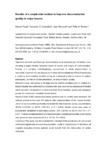Results of a simple intervention to improve documentation quality in major trauma

Ver/Abrir
Use este enlace para citar
http://hdl.handle.net/2183/38815Colecciones
- Investigación (FCS) [1293]
Metadatos
Mostrar el registro completo del ítemTítulo
Results of a simple intervention to improve documentation quality in major traumaFecha
2015-04Cita bibliográfica
Twaij A, Carballido FC, Maryosh J, Pucher PH. Results of a simple intervention to improve documentation quality in major trauma. Eur J Emerg Med. 2015 Apr;22(2):117-20.
Resumen
[Abstract]
Objectives: Accurate and thorough documentation is an important part of medical care, providing a legally binding historical record of events and means of communication. Trauma is a complex multidisciplinary environment, in which documentation is particularly important, but can be poor as a result. We investigate the effect of introducing a proforma documentation booklet, acting as a physical prompt to ensure full patient assessment, as well as full documentation, on documentation quality.
Methods: A case note review of all major trauma patients admitted over 12 months at a district hospital was performed by clinicians with case note review experience 6 months before and after introduction of a trauma booklet. Documentation quality was assessed, as was the presence of complete trauma teams.
Results: A total of 297 consecutive trauma patients over 12 months were reviewed: 136 patients preintervention and 161 patients after implementation of the trauma booklet. Use of a trauma booklet significantly increased the rate of primary survey documentation [82.8% (114/136) vs. 98.8% (159/161), χ P<0.001]. Similar results were seen for documented completion of secondary surveys [39% (53/136) vs. 66.5% (107/161), P<0.001]. Following implementation of a trauma booklet, a significant increase in full trauma team presence was observed (43.4 vs. 67.1%, P<0.001).
Conclusion: This study has demonstrated the potential of the introduction of a structured proforma to significantly improve documentation quality in major trauma. In the future, all hospitals accepting trauma patients could benefit from the introduction of similar proformas.
Palabras clave
Assessment
Communication
Critical care
Documentation
Primary survey
Secondary survey
Surgery
Trauma
Communication
Critical care
Documentation
Primary survey
Secondary survey
Surgery
Trauma
Versión del editor
ISSN
0969-9546





